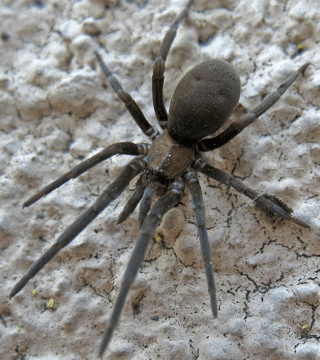This guide initially displays common arthropods (insects, arachnids, centipedes/millipedes and crustaceans) of all shapes. Use the selectors below to include rare species, select by shape, or search by name.
Arthropods include several different classes: hexapods, arachnids, myriapods and crustaceans. An arthropod is an invertebrate animal with bilateral symmetry, an external skeleton, a segmented body, and jointed appendages arranged in pairs. In order to grow, arthropods have to molt, shedding their whole exoskeleton all at once.
Insects, which comprise the vast majority of hexopods, all have three basic body parts. The head has compound eyes, mouthparts, and antennae that are used as sensory organs. The thorax or mid-section typically has two pairs of wings, if the insect can fly, and three pairs of legs for a total of six. The abdomen contains the insect’s digestive system, reproductive organs and sting organs, if present.
While spiders make up the largest group of arachnids, others in the class include scorpions, harvestmen, ticks, mites, pseudoscorpions and solifuges. Arachnids have eight legs plus two additional pairs of appendages: chelicerae used for feeding and defense and pedipalps which function as a sensory organ or in reproduction. Arachnids do not have antennae or wings and have two main body parts with the head and thorax fused into one. In addition, they have two different types of eyes for a total of eight.
Centipedes and millipedes make up most of the myriapod species. They are best known for their long, segmented bodies with multiple legs, though far fewer than their names imply. In addition, they have a single pair of antennae, simple eyes, and mouthparts on the underside of their bodies.
Most crustaceans are free-living aquatic animals but a few are terrestrial such as the woodlice. Their bodies are composed of segments that are grouped into three regions: head, thorax and abdomen. Each body segment may have one or more pairs of appendages which serve as antennae, mandibles, maxillae, legs and tail.
Over 80% of all living animal species are arthropods. They occupy all kinds of roles: predators, prey, parasites, hosts, herbivores and decomposers and live in all different types of habitats. Many are particularly adapted to life in a dry environments like that of Southwest. This guide focuses on many of the common arthropods in the greater Los Alamos area. However, please note that insects in the Lepidoptera order are discussed separately in the Butterfly and Moth Guide.
Insect, Spider and Kin References
A Checklist of Plant and Animal Species at Los Alamos National Laboratory and Surrounding Areas
A Guide to Arthropods Bandelier National Monument, National Park Service [PDF]
American Arachnological Society
Arnett, RH, Jr. 2000 American Insects: A Handbook of the Insects of America North of Mexico CRC Press
BugGuide.Net
Encyclopedia of Life
Field Guide to Insects and Diseases of Arizona and New Mexico Forests, US Forest Service [PDF]
Grasswitz, T.R. and Dressen, D.R. Pocket Guide to the Native Bees of New Mexico [PDF]
Grasswitz, T.R. and Dressen, D.R. Pocket Guide to the Beneficial Insects of New Mexico [PDF]
A Manual of Grasshoppers of New Mexico
iNaturalist
Insect Identification, New Mexico
Mackay, W. and Mackay, E., 2001 The Ants of New Mexico (Hymenoptera: Formicidae) [PDF]
Museum of Southwestern Biology
New Mexico Spiders
Odonata Central
One Hundred Common Insects of New Mexico, NM State University [PDF]
Sanborn, A.F. and Phillips, P.K., 2013 Biogeography of the Cicadas (Hemiptera: Cicadidae) of North America, North of Mexico [PDF]
Symbiota Collections of Arthropods Network
Sutherland, C.A. Rove Beetles [PDF]
Symbiota Collections of Arthropods Network
Ticks and Tick Borne Diseases
Wildlife Notes – Centipedes and Millipedes [PDF]
Subject Area Experts (all guides)
Steve Cary (butterflies)
Beth Cortright (insects)
Terry Foxx (invasive plants)
Leslie Hansen (mammals)
Richard Hansen (fish, mammals)
Dorothy Hoard (butterflies, trees)
Chick Keller (flowers, herbarium)
Shari Kelley (geology)
Kirt Kempter (geology)
Garth Tietjen (reptiles)
David Yeamans (birds)
Web Development and Content Management
Pat Bacha
Jennifer Macke
Graham Mark
Akkana Peck
Contact
Please contact us for local nature questions and sightings. We welcome comments, corrections, and additions to our guides.
For more information about local nature, please visit our Nature Blog or subscribe to PEEC This Week.
Make Selection
 Photo: Ken Schneider  Photo: pgjr75 |  Crevice Weaver(Filistatidae family)Order: Araneae (Spiders) Size: 0.4 - 1 in (9 - 25 mm) Distinguishing Features: females are black, gray or dark brown with black or dark brown velvety-looking legs; males are light brown and mostly glossy with light brown long legs; males are thinner and smaller than females; both sexes have eight eyes clustered together on a central mound Status: native; common Habitat: cracks and crevices of the exterior of buildings; under stones, loose bark, under logs Female Crevice Weavers (top photo) are rarely seen. They build webs around cracks and seldom move except to capture insect and other arthropod prey. The webbing produced by these spiders is not sticky. Rather they use their legs to comb the webbing and create a fine, velcro-like netting that catches the insects legs. In contrast to females, males (bottom photo) typically wander in search of prey and females to mate with. They do not have a set territory but may stray indoors at times. Male Crevice Weavers can be mistaken for the Brown Recluse (see discussion). However, the Crevice Spider has thick black spines on its legs rather than short wispy hairs, is larger and has no violin shape on its back. A female spider can live for up to eight years and produce several hundred eggs at a time. She will guard an egg sac inside her funnel-like retreat until they have hatched and dispersed. Info Photos |
